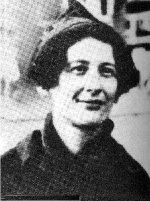
"As I worked in the factory, the affliction of others entered into my flesh and my soul.... There I received for ever the mark of a slave, like the branding of the red-hot iron which the Romans put on the forehead of their most despised slaves. Since then I have always regarded myself as a slave.''
These were the words of Simone Weil, teacher by profession, philosopher and mystic by nature, champion of man's intellectural liberty. She was appalled by the violence in modern society; the oppression of the weak, the fatigue and humiliation of industrial work.
Born in a middle-class Jewish family in Paris in 1909, she obtained her teacher's training certificate in 1931, left France with her parents for the United States in 1942-to evade capture by the Germans, and died a year later as an employee of the Free French Government in England. The twelve years of her adult life can be best described as a series of adventures and involvements. As a teacher at La Puy, she helped industrial workers obtain a pay rise by pleading their cause in the press and joining them in public demonstrations and protest marches. In 1934 she quit school and took employment as a labourer, first in the Alsthom Metal Works, then in the Ateliers de Basse-lndre at Boulogne, and finally in the Renault factory outside Paris. She took up teaching again, and then, in 1936, she went to Barcelona to offer her services as a volunteer in the Spanish war: an episode that ended after a few weeks when she had to be evacuated on account of an accident in which she scalded her hand with oil. Between further teaching assignments she worked in the vineyards of Saint-Marcel-d'Ardeche. Although her health was rarely good she kept going back to physical work.
Simone Weil is not remembered first and foremost as a social activist. During her life she had few friends and she never attracted much public attention. At her funeral in Ashford, England, in 1943, only seven people were present. It was her thoughts and ideas that captured the imagination of many when her not too voluminous letters and essays were published posthumously. This was actually exactly what she had hoped for. She cherished her thoughts and hoped that some day they might benefit other people, though she could not see how this might happen. In one of her last letters she says: "It is a great sorrow for me to fear that the thoughts which have come down into me should be condemned to death."
Knowing that many people today read her writings and are inspired by them would have been a great consolation to her.
Text from: JOHN WIJNGAARDS, Experiencing Jesus, Notre Dame, Indiana 1981.